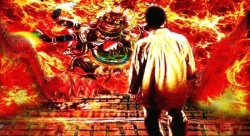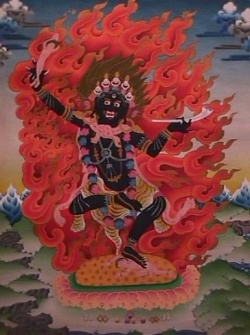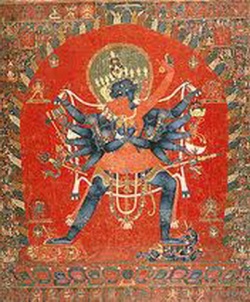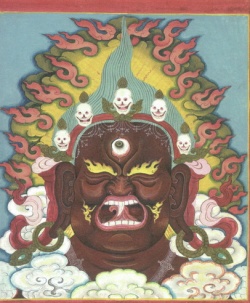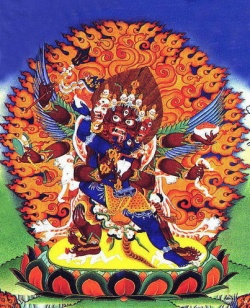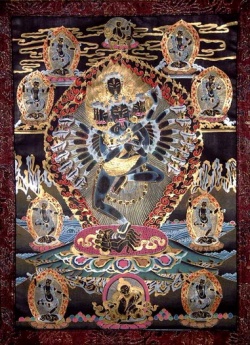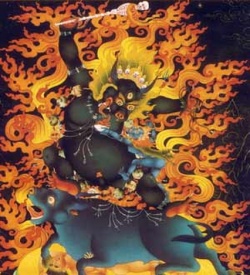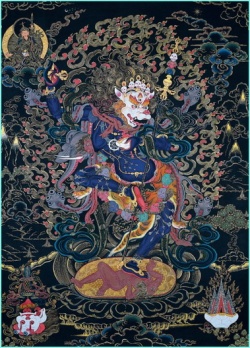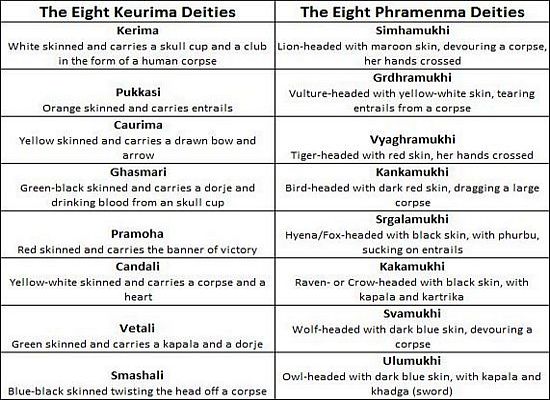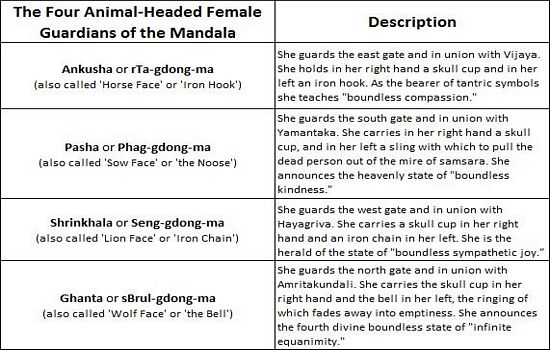Chonyid Bardo: The Vision Of The Wrathful Deities
What are the Wrathful Deities of the Chonyid Bardo? In the Bardo Thodol (Tibetan Book of the Dead), the wrathful deities are figures that are beyond one’s imagination often portrayed in Tibetan art as multi-limbed and multi-headed entities. The wrathful deities are the powerful counterparts of the peaceful deities of the Chonyid Bardo. Literature speak of them as manifesting in otherwordly dimensions, but just like the peaceful deities, they are the manifestations of the karmic fruits and experiences in our life.
From the 12th until the 19th day, the consciousness of the dead person must face these horrifying entities who appear surrounded by flames. Like demonic monsters we commonly see in films, they capture the spirit of the dead and try to drink its blood (symbolizing one’s desires and passions) from cups made out of human skull. Because these visions are so intensely frightening, the consciousness of the dead person tries to get away from them, eventually descending into the lower realms of the after death state until it is propelled to its proper place for rebirth. More on the gory details later.
Another characteristic of the wrathful deities of the bardo is that of having animal heads with human bodies which is something particularly comparable to the gods of ancient Egypt such as Horus (falcon), Thoth (ibis), Anubis (jackal), Bastet (cat), Hathor (cow), Khnum (ram), and Serket (scorpion). Like the animal-headed deities from the Egyptian pantheon, the wrathful deities also have symbolic meanings which can be deciphered by studying what the corresponding animals represent.
Are the Wrathful Deities real?
As mentioned in the previous article, all the peaceful and wrathful deities are only archetypal images of the mind that have no reality of their own. They are empty and cannot harm the body of an enlightened awareness. All the blood-drinking and animal-headed deities of the bardo are mere projections of the intellect and they emerge from the four directions of the third eye chakra.
However, since it was also mentioned that the consciousness of the dead person is already capable of having sensory awareness after it has gone through the first bardo, it experiences the vision of the wrathful deities in full realistic horror, even more unbearable and dreadful than The Exorcist, The Ring, or A Nightmare on Elm Street in 4D. Wait... 4D?
The Purpose of the Wrathful Deities
According to the Tibetan Book of the Dead, all the wrathful deities appear in order to purify awareness of false thinking, ignorance, and delusion. If you are able to recognize the deities by name and see through them as mere illusions, they instantly lose their power over your consciousness and you achieve liberation/enlightenment.
However, any kind of reaction to them that is caused by fear brings you one step closer to rebirth. The effect of the images becomes even stronger if the awareness-body tries to evade or reject them. This simply means that the only way to gain power over these entities is by accepting them as aspects of your own consciousness; avoiding them only makes them more powerful.
Evading or rejecting these visions would cause consciousness to descend into unconsciousness. Figuratively speaking, all your demons (negative karma) are hiding inside the subconscious and wielding their influence over your life now because before you were born, your consciousness wasn’t strong enough to overcome them in the after death state (assuming you accept rebirth as part of your belief system).
It is, therefore, reasonably important for practitioners in Tibetan Buddhism and any other spiritual tradition to pay attention to this fact during their lifetime and distinguish these hidden aspects of consciousness to avoid being overwhelmed once they leave this world. In other words, you have no choice but to face your own fears whether you are dead or alive.
Vision of the Wrathful Deities (Day 12—19)
All the deities you will see here are the polar opposites of the peaceful deities. The wrathful deities appear on a lotus-sun throne of the forehead mandala (third eye chakra) and stand in a blazing aureole of flames. There are five types of deities that one might encounter during this experience:
- The Powerful Mahasri-Heruka
- The Five Blood-Drinking Deities
- The Eight Keurima & The Eight Phramenma Deities
- The Four Animal-Headed Female Guardians of the Mandala
- The 28 Animal-Headed Deities
Since they are quite numerous, I can only provide a short description for each group of deities. If you are interested to know more about them, you can search their names on Google/Wikipedia, or perhaps even better, read the English translations of the Tibetan Book of the Dead. Also, it’s quite hard to find pictures that exactly fit the descriptions I have, so forgive me if this creates a little bit of confusion.
1. The Powerful Mahasri-Heruka
The visions start with Mahasri-Heruka, the lord of the "blood-drinking deities.” He is the tremendously wrathful expression of Adibuddha (the source of all the buddhas and bodhisattvas in the bardo). Mahasri-Heruka is usually depicted as red-brown in color with three heads, nine eyes, six arms, and four legs surrounded by a ring of flames. His right face is the color of smoke, the middle is white, and the left is red. In his three right hands he carries a short metal weapon called vajra, a trident, and a drum with a handle. In his left hands he carries a bella skull cup, and a sling made from innards. He is usually depicted in tantric union or "yab yum" with his dakini, whose color is pure white. Like the Adibuddha, the powerful Mahasri-Heruka occupies a special position among the bardo deities and all of the symbols associated with him have specific meanings.
2. The Five Blood-Drinking Deities
The next vision involves the Five Blood-Drinking deities (a.k.a. Buddha-Herukas) in tantric union with their five dakinis. Their purpose is to annihilate the five principal failings of human behavior (ignorance, hatred, pride, passion, and envy) while the five dakinis enlighten the five elemental realms (earth, fire, air, ether). All of them have three heads, six arms, and four legs and are adorned with crowns of skulls and skull-necklaces. They are usually depicted in paintings with wings of the garuda bird, a mythical bird that symbolizes the power to overcome evil.
1. Buddha-Heruka - appears in the center with his smoky-white dakini Krodhesvari. This wrathful Heruka is an emanation of Buddha Vairocana, manifesting himself in a terrifying flaming form. In his right hands he carries a long-handled axe, a flaming sword, and the wheel of the teachings; in his left, a kapala, a ploughshare, and a bell.
2. Vajra- Heruka (dark blue ) – appears in the east with his dakini Vajra-Krodhesvari
3. Ratna-Heruka (yellow) –appears in the south with his dakini Ratna-Krodhesvari
4. Padma-Heruka (red) – appears in the west his dakini Padma-Krodhesvari
5. Karma-Heruka (green) – appears in the north with his dakini Karma-KrodhesVari
Note: The descriptions do not match the picture.
3. The Eight Keurima & The Eight Phramenma Deities
The next vision involves the Eight Keurima and the Eight (animal-headed) Phramenma. All of these deities originate from the various regions of the head. They wear leopard-skins and hover in empty space, surrounded by blazing flames. They should not be feared, but instead be considered as mere projections of the mind. Psychologically, they have the same purpose as the Eight Mahabodhisattvas and their Dakinis.
The Eight Keurima are the counterparts of the Eight Mahabodhisattvas from the mandala of the peaceful deities. Their sole purpose is to purify and enlighten the eight kinds of awareness (the psychic organs of perception). The Keurima are divided into two groups. The first group of dakinis is of the cardinal directions of the mandala and of pure colors. The other four are of the intermediate directions with mixed colors.
The Eight Phramenma are the animal-headed deities who rule over the eight realms of consciousness (the corresponding physical organs of perception). They are the wrathful counterparts of the eight dakinis of the Eight Mahabodhisattvas. Four of the Phramenma have animal heads and they correspond to the four cardinal directions of the eight-petalled lotus. The other four have bird heads and correspond to the intermediate directions.
4. The Four Animal-Headed Female Guardians of the Mandala
The next vision involves the Four Animal-Headed Female Guardians. Their purpose is to indicate to the dead person its four boundaries. These boundaries represent the Buddhist philosophical concept of the "Four Sublime States" (compassion, loving-kindness, sympathetic joy, and equanimity).
5. The 28 Animal-Headed Deities
Finally, the awareness-body comes face to face with the rest of the crew, the 28 powerful Animal-headed Deities who are enjoying their sumptuous banquet of corpses, internal organs, and blood. Their purpose is to help consciousness to overcome any remaining false ideas and karmic hindrances so that it may be freed from all passions and attachments.
The end of the Chonyid Bardo Visions
During the entire period of the Chonyid Bardo experience, the lama or guru keeps on reminding the consciousness of the dead person through the death ritual how important it is to recognize these images as one’s own thought-forms even if he spent years of his life studying scriptures or practicing tantric techniques. Failure to do so at this point means failure to achieve liberation, moksha, or buddhahood. Also, if one flees from the thought-forms out of fear all-throughout the visual experience of the wrathful deities, all of them will finally transform to the most powerful and terrifying aspect of the Lord of Death, Dharma-Raja, who represents ignorance, hate, and greed. The peaceful deities, on the other hand, turn into a powerful protective deity called Mahakala representing wisdom and enlightenment, although still wrathful in form.
- “They will come having their upper teeth biting the nether lip; their eyes glassy; their hairs tied up on the top of the head; big-bellied, narrow-wasted; holding a karmic record-board in the hand; giving utterance from their mouth to sounds of 'Strike! Slay!', licking human brain, drinking blood, tearing heads from corpses, tearing out the hearts…”
Now you can just imagine how this can turn out to be such a bad day for the dead person without someone reminding him that it is not real. This is also why sacrifices and prayers are given as part of the death ritual just so the dead can make it through the dangers of the afterlife.
From a psychological standpoint, these visions are seen as the processes of instinctual life, the repressed emotions, and the core patterns of memory and perception that are hidden from our consciousness. Carl Jung refers to this process, taking place in real life, as an encounter with the shadow. When this happens, the elements that occupy the unconscious mind try to penetrate consciousness and force the individual to face his own demons which are projected into the outside world. For Buddhists, the only way to overcome this in life, or even in death, is through the expansion of one’s consciousness. In the next article, I will discuss the Sidpa Bardo wherein the journey through the six realms of existence and the search for the next place of rebirth take place. Say your prayers before going to bed, ayt?
